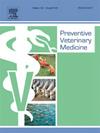Assessment of communal farmers’ knowledge of foot-and-mouth disease (FMD) within the FMD protection zone with vaccination of Limpopo and Mpumalanga Provinces, South Africa
IF 2.2
2区 农林科学
Q1 VETERINARY SCIENCES
引用次数: 0
Abstract
Foot-and-mouth disease (FMD) is a highly contagious disease affecting domestic livestock and its control in South Africa depends on methods including event-based surveillance and the reporting of disease by farmers. This study assessed FMD knowledge level among small-scale, communal livestock farmers in South Africa's FMD zone with vaccination. A cross-sectional study was conducted with 629 farmers from 44 dip-tanks (animal assembly points). A FMD knowledge score was derived from 25 yes/no questions with scores above the median classified as high FMD knowledge. Mixed-effects logistic regression was used to evaluate predictors of high FMD knowledge with associations reported as odds ratios (OR) and their corresponding 95 % confidence intervals (CI). Eighty percent of the participants were male and 65 % aged 60 or older. The most common livestock raised was cattle (98.1 %). Sixty-six percent (415/629) of the interviewed farmers reported that they were aware of the existence of FMD. Formal education (OR 2.0, 95 % CI, 1.4–2.9, P < 0.001), poultry ownership (OR 1.7, 95 % CI 1.1–2.5, P = 0.006), livestock farming as the main occupation (OR 1.6, 95 % CI 1.1–2.3, P = 0.026) and the total livestock units of their farm (OR 1.5, 95 % CI 1.1–1.9, P = 0.002) were significant predictors of FMD recognition. Most respondents (54 %) that claimed to be aware of the existence of FMD did not know that African buffalos were a source of FMD virus. Also, less than half of the respondents cited lameness (38 %) and excessive salivation (37 %) as the main FMD clinical signs. Only a small proportion (2.4 %) of these respondents were aware that movement of infected animals can cause FMD virus to spread to new areas. FMD knowledge scores were calculated for the 415 respondents claiming to be aware of the existence FMD with 174 (42 %) having a total knowledge score greater than the median (hereafter referred to as “high FMD knowledge” compared to the rest of the farmers). Farmers from Vhembe District in Limpopo had an odds of high FMD knowledge four times higher than those in Ehlanzeni District in Mpumalanga (OR 4.0, 95 % CI 1.7–9.4, P = 0.002). Farmers that owned more than 15 cattle (OR 1.7, 95 % CI 1.0–2.8, P = 0.035) and farmers that supervised their own cattle during grazing (OR 1.6, 95 % CI 1.0–2.5, P = 0.043) also had a significantly higher odds of high FMD knowledge. Communal farmers in South Africa have gaps in their FMD knowledge and specifically were not aware that movement of infected animals and their products pose a threat for the spread of FMD. Comprehensive information, education and training for communal livestock farmers are essential for improving event-based surveillance and FMD prevention and control in the region.
评估南非林波波省和姆普马兰加省口蹄疫保护区内社区农民的口蹄疫知识及疫苗接种情况
口蹄疫是一种影响家畜的高度传染性疾病,其在南非的控制取决于基于事件的监测和农民的疾病报告等方法。这项研究通过接种口蹄疫疫苗评估了南非口蹄疫疫区小规模社区畜牧农民的口蹄疫知识水平。对来自44个水池(动物集合点)的629名农民进行了横断面研究。口蹄疫知识得分由25个是/否问题得出,得分高于中位数的问题被归类为口蹄疫知识高。混合效应逻辑回归用于评估高口蹄疫知识的预测因子,其相关性报告为比值比(OR)及其相应的95% %置信区间(CI)。80%的参与者是男性,65%的参与者年龄在60岁以上。最常见的牲畜是牛(98.1%)。66%(415/629)的受访农民报告说,他们知道口蹄疫的存在。正规教育(或2.0 95 % CI, 1.4 - -2.9, P & lt; 0.001),家禽所有权(95 %可信区间1.1 - -2.5或1.7,P = 0.006),畜牧业为主要占领(95 %可信区间1.1 - -2.3或1.6,P = 0.026)和总他们农场的牲畜单位(95 %可信区间1.1 - -1.9或1.5,P = 0.002)是手足口病识别的重要预测因子。大多数应答者(54% %)声称知道口蹄疫的存在,但不知道非洲水牛是口蹄疫病毒的一个来源。此外,不到一半的受访者认为跛行(38% %)和过度流涎(37% %)是口蹄疫的主要临床症状。这些答复者中只有一小部分人(2.4 %)知道受感染动物的移动会导致口蹄疫病毒传播到新的地区。对415名声称知道口蹄疫存在的受访者计算口蹄疫知识得分,其中174名(42% %)的总知识得分高于中位数(下文称为“口蹄疫知识较高”)。林波波省Vhembe县的农民对口蹄疫知识的了解程度比姆普马兰加省Ehlanzeni县的农民高4倍(OR 4.0, 95 % CI 1.7-9.4, P = 0.002)。拥有15头以上牛的农民(OR 1.7, 95 % CI 1.0-2.8, P = 0.035)和放牧期间监督自己的牛的农民(OR 1.6, 95 % CI 1.0-2.5, P = 0.043)也具有较高的口蹄疫知识的几率。南非的社区农民在口蹄疫知识方面存在差距,特别是没有意识到受感染动物及其产品的流动对口蹄疫的传播构成威胁。为社区畜牧农民提供全面的信息、教育和培训对于改善该地区基于事件的监测和口蹄疫防控至关重要。
本文章由计算机程序翻译,如有差异,请以英文原文为准。
求助全文
约1分钟内获得全文
求助全文
来源期刊

Preventive veterinary medicine
农林科学-兽医学
CiteScore
5.60
自引率
7.70%
发文量
184
审稿时长
3 months
期刊介绍:
Preventive Veterinary Medicine is one of the leading international resources for scientific reports on animal health programs and preventive veterinary medicine. The journal follows the guidelines for standardizing and strengthening the reporting of biomedical research which are available from the CONSORT, MOOSE, PRISMA, REFLECT, STARD, and STROBE statements. The journal focuses on:
Epidemiology of health events relevant to domestic and wild animals;
Economic impacts of epidemic and endemic animal and zoonotic diseases;
Latest methods and approaches in veterinary epidemiology;
Disease and infection control or eradication measures;
The "One Health" concept and the relationships between veterinary medicine, human health, animal-production systems, and the environment;
Development of new techniques in surveillance systems and diagnosis;
Evaluation and control of diseases in animal populations.
 求助内容:
求助内容: 应助结果提醒方式:
应助结果提醒方式:


